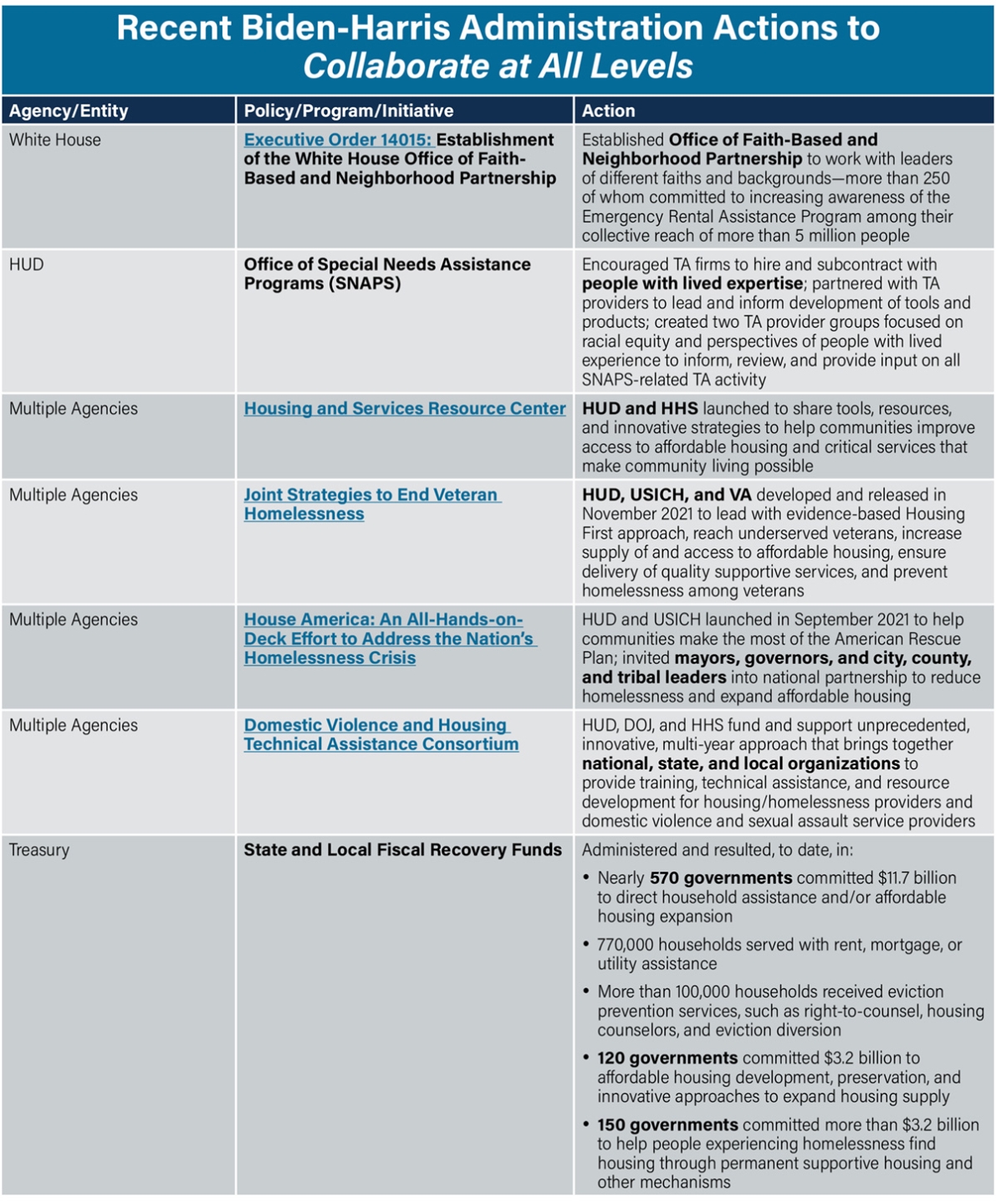Collaborate at All Levels
This is an excerpt of All In: The Federal Strategic Plan to Prevent and End Homelessness. Read the full plan at usich.gov/all-in.
All In serves as a roadmap for federal action to ensure state and local communities have sufficient resources and guidance to build the effective, lasting systems required to end homelessness. While it is a federal plan, local communities can use it to collaboratively develop local and systems-level plans for preventing and ending homelessness. This plan creates an initial framework for meeting the ambitious goal of reducing overall homelessness by 25% by 2025 and sets the United States on a path to end homelessness.
This plan is built around six pillars: three foundations—equity, evidence, and collaboration—and three solutions—housing and supports, homelessness response, and prevention—all of which are required to prevent and end homelessness. Within each pillar of foundations and solutions are strategies that the federal government will pursue to facilitate increased access to housing, economic security, health, and stability. Some agency commitments, cross-government initiatives, and efforts are already underway and are highlighted throughout.
Upon release of this plan, USICH will immediately begin to develop implementation plans that will identify specific actions, milestones, and metrics for operationalizing the strategies in close partnership with its member agencies and other stakeholders representing a broad range of groups and perspectives, including people with lived experience. For more on this, please view the Framework for Implementation.
Strategies to Collaborate at All Levels
A core function of USICH is to break down silos and improve coordination across the federal government and with state and local governments, educational systems and providers, territories, tribes, Native-serving organizations operating off tribal land, CoCs, public and private organizations, philanthropy, and people who have experienced homelessness. Interdisciplinary, interagency, and intergovernmental action is required to effectively create comprehensive responses to the complex problem of homelessness.
Strategy 1: Promote collaborative leadership at all levels of government and across sectors.
Successful implementation of this plan will only occur when there is broad support and leadership from all levels of government and all sectors. At the local level, collaboration is necessary between business and civic leaders, public officials, faith-based organizations, and mainstream systems and programs that provide housing, employment, education, legal, human services, and health care.
To accomplish this strategy, USICH and relevant member agencies will:
- Engage in a cross-agency media campaign to educate the public on the scope, causes, costs, and solutions to homelessness.
- Engage state and local leaders in a renewed commitment to prevent and end homelessness and provide TA and guidance to state and local governments, territories, tribes, and Native-serving organizations operating off tribal land on how to create local action plans that are aligned with the federal strategic plan but reflective of local conditions and resources.
- Launch targeted and place-based cross-agency technical assistance strategies to drive progress on preventing and ending homelessness in regions with highest rates of homelessness.
- Authentically engage people with lived experience and people from historically marginalized groups in all aspects of planning and implementation. Expand partnerships with philanthropy to fill resource gaps, leverage government resources, and hold government accountable for better performance.
- Identify opportunities to engage businesses, nonprofits, and faith-based organizations on relevant issues related to ending and preventing homelessness.
- Develop and implement strategies to support organizations that receive federal funding to maintain and increase staff capacity, reduce burnout, increase compensation to a living wage, and promote the well-being of staff.
Strategy 2: Improve information-sharing with public and private organizations at the federal, state, and local level.
Communities have been adopting more strategic approaches to prevent and end homelessness— collaborating effectively, directing resources toward evidence-informed practices, monitoring and making performance improvements, and targeting interventions based on household needs and strengths. The federal government should better support this ongoing work by providing the tools and resources needed for success.
To accomplish this strategy, USICH and relevant member agencies will:
- Coordinate relevant federal TA resources and provide information to CoCs, state and local governments, aging-and disability- network organizations, territories, tribes, school districts, local housing and service providers, and Native-serving organizations operating off tribal land on how to access the support they need.
- Launch a coordinated messaging campaign to challenge public narratives that stigmatize, blame, and dehumanize people experiencing homelessness and to combat local opposition to new affordable housing development and local laws which criminalize homelessness.
-
Make information more readily available and accessible on best practices and strategies to finance them at scale as well as tailored guidance and tools for key populations and geographic areas.



